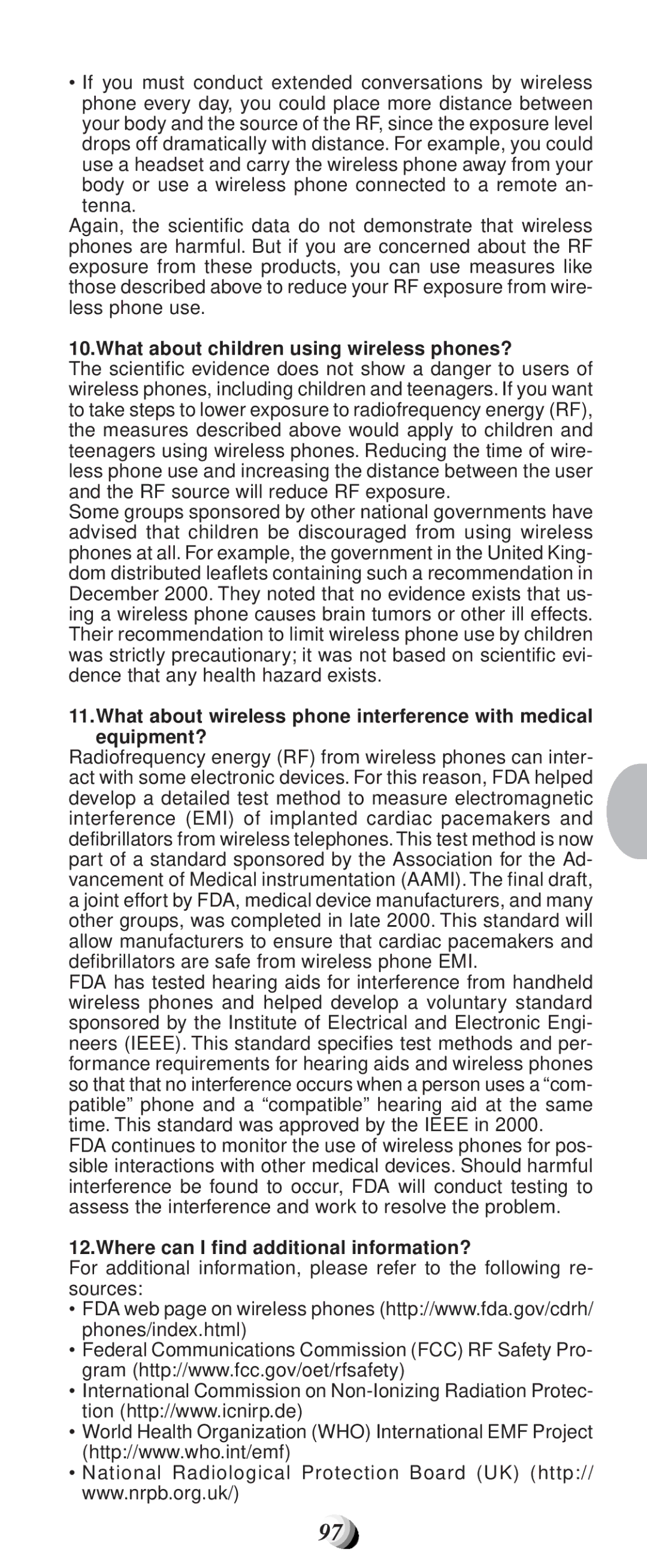
•If you must conduct extended conversations by wireless phone every day, you could place more distance between your body and the source of the RF, since the exposure level drops off dramatically with distance. For example, you could
use a headset and carry the wireless phone away from your body or use a wireless phone connected to a remote an- tenna.
Again, the scientific data do not demonstrate that wireless phones are harmful. But if you are concerned about the RF exposure from these products, you can use measures like those described above to reduce your RF exposure from wire- less phone use.
10.What about children using wireless phones?
The scientific evidence does not show a danger to users of wireless phones, including children and teenagers. If you want to take steps to lower exposure to radiofrequency energy (RF), the measures described above would apply to children and teenagers using wireless phones. Reducing the time of wire- less phone use and increasing the distance between the user and the RF source will reduce RF exposure.
Some groups sponsored by other national governments have advised that children be discouraged from using wireless phones at all. For example, the government in the United King- dom distributed leaflets containing such a recommendation in December 2000. They noted that no evidence exists that us- ing a wireless phone causes brain tumors or other ill effects. Their recommendation to limit wireless phone use by children was strictly precautionary; it was not based on scientific evi- dence that any health hazard exists.
11.What about wireless phone interference with medical equipment?
Radiofrequency energy (RF) from wireless phones can inter- act with some electronic devices. For this reason, FDA helped develop a detailed test method to measure electromagnetic interference (EMI) of implanted cardiac pacemakers and defibrillators from wireless telephones. This test method is now part of a standard sponsored by the Association for the Ad- vancement of Medical instrumentation (AAMI). The final draft, a joint effort by FDA, medical device manufacturers, and many other groups, was completed in late 2000. This standard will allow manufacturers to ensure that cardiac pacemakers and defibrillators are safe from wireless phone EMI.
FDA has tested hearing aids for interference from handheld wireless phones and helped develop a voluntary standard sponsored by the Institute of Electrical and Electronic Engi- neers (IEEE). This standard specifies test methods and per- formance requirements for hearing aids and wireless phones so that that no interference occurs when a person uses a “com- patible” phone and a “compatible” hearing aid at the same time. This standard was approved by the IEEE in 2000.
FDA continues to monitor the use of wireless phones for pos- sible interactions with other medical devices. Should harmful interference be found to occur, FDA will conduct testing to assess the interference and work to resolve the problem.
12.Where can I find additional information?
For additional information, please refer to the following re- sources:
•FDA web page on wireless phones (http://www.fda.gov/cdrh/ phones/index.html)
•Federal Communications Commission (FCC) RF Safety Pro- gram (http://www.fcc.gov/oet/rfsafety)
•International Commission on
•World Health Organization (WHO) International EMF Project (http://www.who.int/emf)
•National Radiological Protection Board (UK) (http:// www.nrpb.org.uk/)
97
